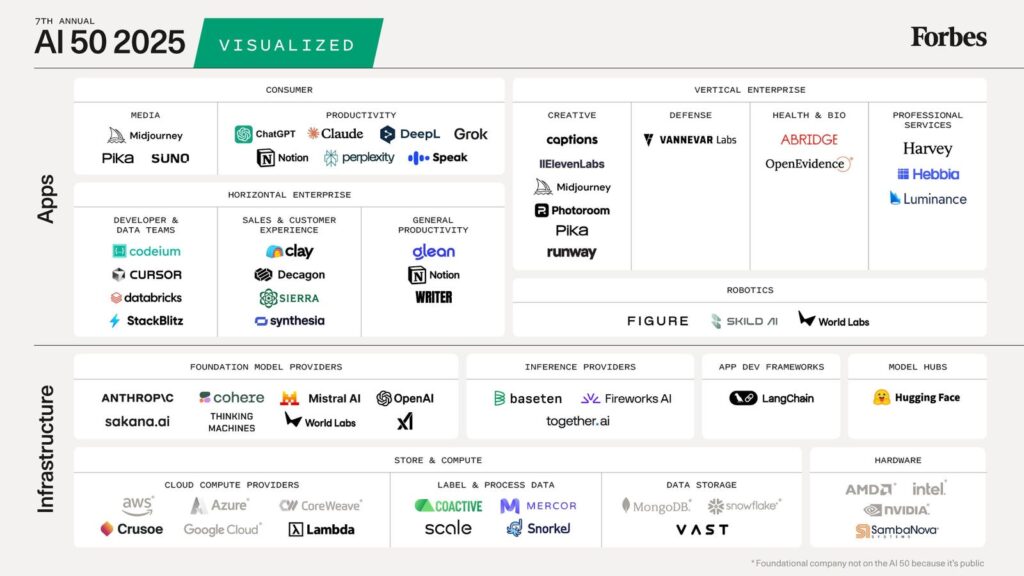The 2025 edition of the AI 50 list shows how companies are using agents and reasoning models to start replacing work previously done by people at scale.
Artificial intelligence is entering a new phase in 2025. After years of AI tools mostly answering questions or generating content on command, this year’s innovations are about AI actually getting work done. The 2025 Forbes AI 50 list illustrates this pivotal shift, as startups on it signal a move from AI that merely responds to prompts to one that solves problems and completes entire workflows. For all the buzz around big AI model makers like OpenAI, Anthropic or xAI, the biggest changes to the story in 2025 are in these application-layer tools that use AI to produce real business results.
Sequoia
From chatbots to completing workflows
Historically, AI assistants could chat or provide information, but humans still had to act on the output. In 2025, that’s changing. For example, legal AI startup Harvey is showing that its software can do more than just answer legal questions–it can handle entire legal workflows, from document review to predictive analysis of cases. Its platform can draft documents, suggest revisions and even help automate negotiations, case management and client contact—suites of tasks that normally require a team of junior lawyers. This achievement earned Harvey a spot on the Forbes AI 50 list, and it exemplifies AI evolving from a helpful tool to a hands-on problem solver.
Enterprise tools leading the way
Many of the standout AI 50 companies are enterprise tools that do on-the-job work. Sierra and Cursor, the only product of startup Anysphere, are emblematic of this new generation of business AI. Sierra automates customer service while vastly improving the experience, opening the way for companies to offer help to their customers at all hours. Cursor, meanwhile, has taken the software developer community by storm. Its technology allows anyone to not only autocomplete lines of code (à la GitHub CoPilot), but also generate entire features and applications simply by asking for it in plain English.
Robotics on the rise
Although we’re not yet at a point where companies are deploying robots en masse, startups focused on robotics have made meaningful strides in the past year as they integrate models built using transformers (the “t” in ChatGPT) with hardware. Robotics featured prominently in Nvidia’s keynote at its recent developer conference, with Jensen Huang claiming, “physical AI for industrial and robotics is a $50 trillion opportunity.” Figure AI recently announced its BotQ high-volume manufacturing facility capable of producing 12,000 of its humanoid robots a year along with its new generalist Vision-Language-Action (VLA) model, Helix. Another AI 50 company, Skild AI, is taking a different approach, focusing on developing a universal robotics foundation model, Skild Brain, that can be integrated into a wide variety of robots, rather than building its own. Skild is also planning to sell services to the robotics industry that use Skild Brain.
Consumers on the cusp of AI productivity
So far, everyday consumers have mainly encountered advanced AI via chatbots like OpenAI’s ChatGPT or Anthropic’s Claude (and newcomers like Grok). Hundreds of millions have tried talking to these AI tools, but we’ve yet to see a truly mainstream app where AI completes everyday tasks for people. That is likely to change in 2026. With the technology maturing—and people realizing how AI can save them time and money at work—expect a wave of consumer-facing AI products that handle whole tasks on their users’ behalf. For example, Anthropic recently launched Claude Code, making software writing accessible to consumers. These new capabilities raise the prospect that AIs able to manage your schedule, book travel or organize your files end-to-end are on the horizon.
2025 as Turning Point, 2026 for Wider Adoption
This year is a turning point: AI graduated from an answer engine to an action engine in the workplace. The 2025 AI 50 companies proved that AI can be trusted with meaningful workloads and deliver real results, setting the stage for broader adoption. As we head into 2026, expect the enterprise gains to start spilling into everyday life. Challenges like accuracy and security remain, but the momentum is undeniable. In 2025, AI gets real work done.


